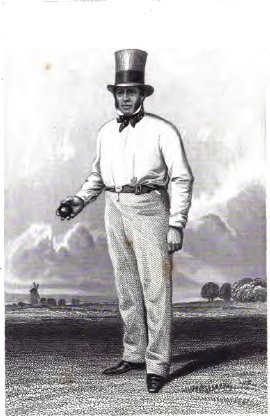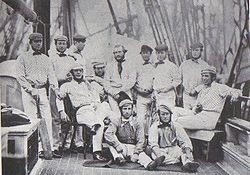
William Clarke's All-England Eleven
Encyclopedia
The All-England Eleven (AEE) was an itinerant all-professional first-class cricket
team created in 1846 by Nottinghamshire
cricketer William Clarke. Widely known by its acronym AEE, it took advantage of opportunities offered by the newly developed railways to play against local teams throughout Great Britain and made its profit by receiving payments from the home clubs. In 1852, some players broke away from the AEE to form the United All-England Eleven
(UEE). Similar enterprises were launched in the following years including the United North of England Eleven
(UNEE) and Edgar Willsher
's United South of England Eleven
(USEE) which became strongly associated with WG Grace.
Clarke, as well as being the manager, was the captain
of the AEE team until his death in 1856. He was suucceeded by his Nottinghamshire colleague George Parr
who agreed that the AEE and UEE should regularly play against each other, something that Clarke would not allow. In 1859, the first England national cricket team was formed as a composite of the AEE and the UEE to tour North America
.
With the rise of county cricket
and the introduction of international cricket, the travelling elevens lost influence and popularity. The AEE gradually faded from the scene and had disappeared by 1880.
 In the late 1840s, Nottinghamshire CCC
In the late 1840s, Nottinghamshire CCC
player William Clarke recognised that a professional touring eleven could enhance the local and fragmented popularity of cricket. In 1846, he founded what would become known as the "All-England Eleven" as an all-professional team that played a few games in the North of England against more-than-eleven local teams. He originally called his side "Eleven of England". The squad arguably comprised the best English professional players of the time, as well as two nominally "amateur" cricketers, Alfred Mynn
and Nicholas Felix. The All-England Eleven was inundated with requests for fixtures and received a payment from its opponents (who could in turn hope for a large attendance). During the following years, helped by the development of railways, the team regularly toured Great Britain, doing much to increase the popularity of the game in areas that had previously not seen high class cricket.
 The players were better paid by Clarke than they were by the Marylebone Cricket Club
The players were better paid by Clarke than they were by the Marylebone Cricket Club
or the counties but Clarke, who was captain
as well as manager of the team, received by far the largest part of the profit. In 1852 some of the professionals, led by John Wisden
and Jemmy Dean
, were dissatisfied by Clarke's ungenerous and undemocratic behaviour and sought larger wages. They broke away from the team and created the United All-England Eleven
. Other similar teams appeared from the late 1850s.
George Parr
led the team after Clarke's death in 1856. From 1857 the two main "All-England Elevens" regularly played against each other. In 1859, six members of each team composed the squad of the first ever overseas touring English team
, which several played games in the United States
and in Canada
.
First-class cricket
First-class cricket is a class of cricket that consists of matches of three or more days' scheduled duration, that are between two sides of eleven players and are officially adjudged first-class by virtue of the standard of the competing teams...
team created in 1846 by Nottinghamshire
Nottinghamshire County Cricket Club
Nottinghamshire County Cricket Club is one of the 18 major county clubs which make up the English and Welsh domestic cricket structure, representing the historic county of Nottinghamshire, and the current county champions. Its limited overs team is called the Nottinghamshire Outlaws...
cricketer William Clarke. Widely known by its acronym AEE, it took advantage of opportunities offered by the newly developed railways to play against local teams throughout Great Britain and made its profit by receiving payments from the home clubs. In 1852, some players broke away from the AEE to form the United All-England Eleven
United All-England Eleven
The United All-England Eleven was an English cricket team formed in 1852 by players breaking away from William Clarke's All-England Eleven . Key UEE players included John Wisden and Jemmy Dean, who became joint secretaries of the team....
(UEE). Similar enterprises were launched in the following years including the United North of England Eleven
United North of England Eleven
The United North of England Eleven was an itinerant cricket team founded in 1869 by George Freeman and Roger Iddison with the backing of Lord Londesborough who became the team's president. As its name suggests, its purpose was to bring together the best players of England's northern counties and...
(UNEE) and Edgar Willsher
Edgar Willsher
Edgar "Ned" Willsher was an English cricketer who is famous for being the catalyst in the shift from roundarm to overarm bowling....
's United South of England Eleven
United South of England Eleven
The United South of England Eleven was an itinerant cricket team founded in November 1864 by Edgar Willsher, as secretary, and John Lillywhite, as treasurer....
(USEE) which became strongly associated with WG Grace.
Clarke, as well as being the manager, was the captain
Captain (cricket)
The captain of a cricket team often referred to as the skipper is the appointed leader, having several additional roles and responsibilities over and above those of a regular player...
of the AEE team until his death in 1856. He was suucceeded by his Nottinghamshire colleague George Parr
George Parr (cricketer)
George Parr was an English cricketer, whose first-class career lasted from 1844 to 1870....
who agreed that the AEE and UEE should regularly play against each other, something that Clarke would not allow. In 1859, the first England national cricket team was formed as a composite of the AEE and the UEE to tour North America
England cricket team in North America in 1859
The English cricket team in North America in 1859 was the first ever overseas cricket tour.-Organisation:The idea for the tour came from WP Pickering , who had been captain of cricket at Eton College in 1837 and 1838. He had emigrated to Canada in 1852 and played for Canada against the United...
.
With the rise of county cricket
County cricket
County cricket is the highest level of domestic cricket in England and Wales. For the 2010 season, see 2010 English cricket season.-First-class counties:...
and the introduction of international cricket, the travelling elevens lost influence and popularity. The AEE gradually faded from the scene and had disappeared by 1880.
History

Nottinghamshire County Cricket Club
Nottinghamshire County Cricket Club is one of the 18 major county clubs which make up the English and Welsh domestic cricket structure, representing the historic county of Nottinghamshire, and the current county champions. Its limited overs team is called the Nottinghamshire Outlaws...
player William Clarke recognised that a professional touring eleven could enhance the local and fragmented popularity of cricket. In 1846, he founded what would become known as the "All-England Eleven" as an all-professional team that played a few games in the North of England against more-than-eleven local teams. He originally called his side "Eleven of England". The squad arguably comprised the best English professional players of the time, as well as two nominally "amateur" cricketers, Alfred Mynn
Alfred Mynn
Alfred Mynn was an English cricketer during the game's "Roundarm Era". He was a genuine all-rounder, being both an attacking right-handed batsman and a formidable right arm fast bowler. The noted cricket writer John Woodcock ranked him as the fourth greatest cricketer of all time. Simon Wilde...
and Nicholas Felix. The All-England Eleven was inundated with requests for fixtures and received a payment from its opponents (who could in turn hope for a large attendance). During the following years, helped by the development of railways, the team regularly toured Great Britain, doing much to increase the popularity of the game in areas that had previously not seen high class cricket.

Marylebone Cricket Club
Marylebone Cricket Club is a cricket club in London founded in 1787. Its influence and longevity now witness it as a private members' club dedicated to the development of cricket. It owns, and is based at, Lord's Cricket Ground in St John's Wood, London NW8. MCC was formerly the governing body of...
or the counties but Clarke, who was captain
Captain (cricket)
The captain of a cricket team often referred to as the skipper is the appointed leader, having several additional roles and responsibilities over and above those of a regular player...
as well as manager of the team, received by far the largest part of the profit. In 1852 some of the professionals, led by John Wisden
John Wisden
John Wisden was an English cricketer who played 190 first-class cricket matches for three English county cricket teams, Kent, Middlesex and Sussex...
and Jemmy Dean
Jemmy Dean
James "Jemmy" Dean was an English cricketer who played for Sussex County Cricket Club in the 19th century....
, were dissatisfied by Clarke's ungenerous and undemocratic behaviour and sought larger wages. They broke away from the team and created the United All-England Eleven
United All-England Eleven
The United All-England Eleven was an English cricket team formed in 1852 by players breaking away from William Clarke's All-England Eleven . Key UEE players included John Wisden and Jemmy Dean, who became joint secretaries of the team....
. Other similar teams appeared from the late 1850s.
George Parr
George Parr (cricketer)
George Parr was an English cricketer, whose first-class career lasted from 1844 to 1870....
led the team after Clarke's death in 1856. From 1857 the two main "All-England Elevens" regularly played against each other. In 1859, six members of each team composed the squad of the first ever overseas touring English team
England cricket team in North America in 1859
The English cricket team in North America in 1859 was the first ever overseas cricket tour.-Organisation:The idea for the tour came from WP Pickering , who had been captain of cricket at Eton College in 1837 and 1838. He had emigrated to Canada in 1852 and played for Canada against the United...
, which several played games in the United States
United States
The United States of America is a federal constitutional republic comprising fifty states and a federal district...
and in Canada
Canada
Canada is a North American country consisting of ten provinces and three territories. Located in the northern part of the continent, it extends from the Atlantic Ocean in the east to the Pacific Ocean in the west, and northward into the Arctic Ocean...
.

